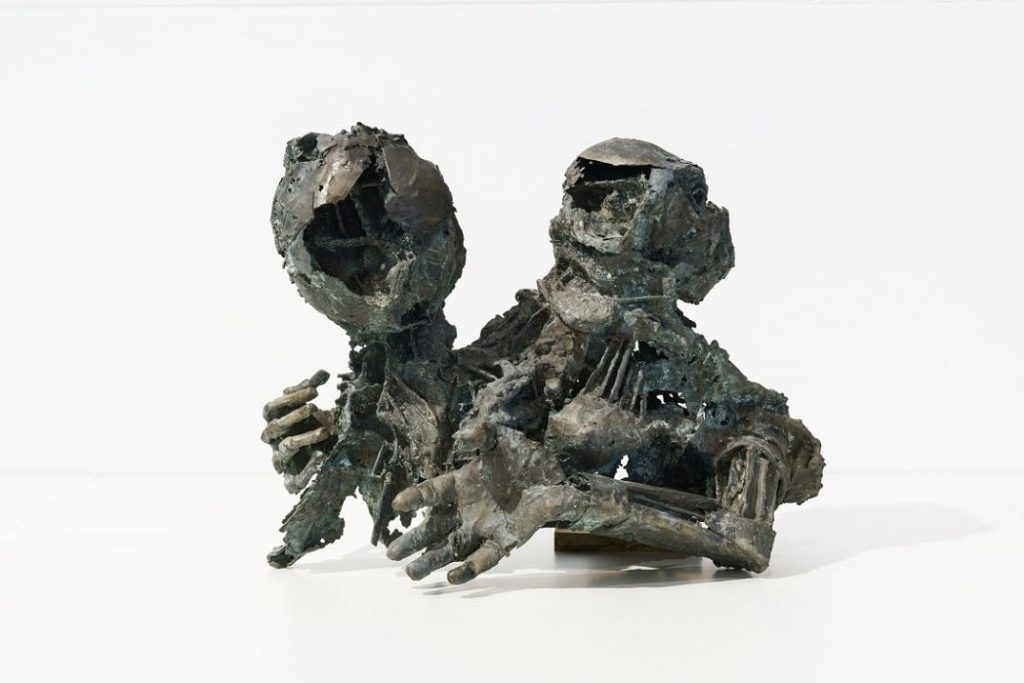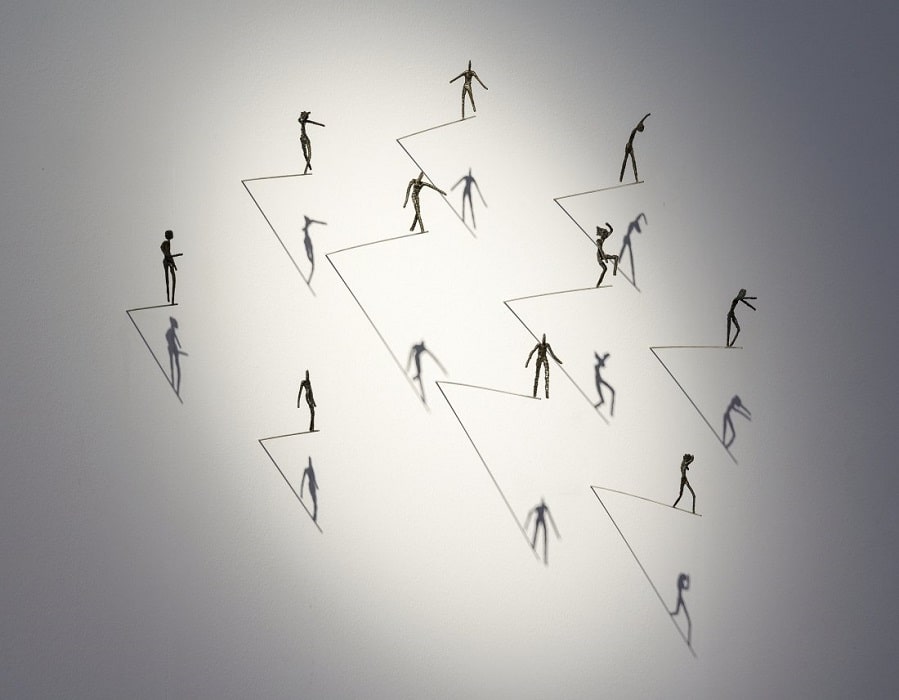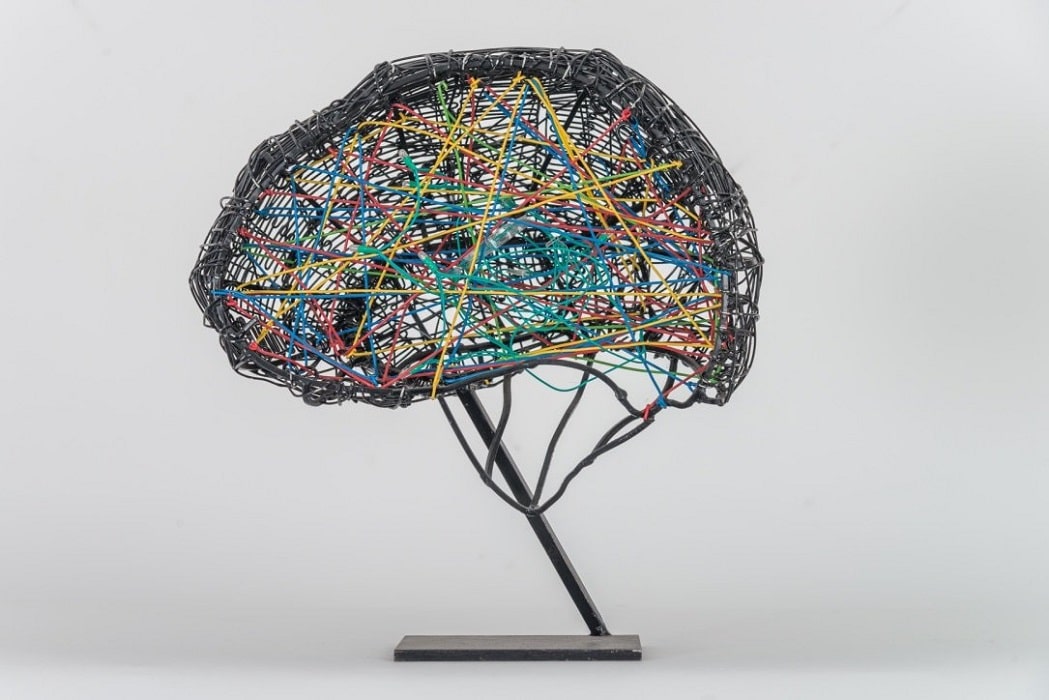“He who is only in motion loses his orientation, he who always sees the whole loses the part, he who always searches loses himself on the horizon, and he who always finds abandons himself to chance”, said Jean-Christopher Ammann (1939-2015) at the inauguration speech of the sculpture Walking Man by E. R. Nele in 2001. The great art connoisseur, exhibition organiser and museum director said this in view of the frozen movement of the high-wire artist carrying a pole on a steel cable.
Image Above: Brain / Networking Model for a large sculpture at the Max Planck Institute for Brain Research, 2001 © E. R. Nele
E. R. Nele, it seems when you talk to her, experience her, was always on the move, wide awake, and always paused with presence of mind at special moments in contemporary events, never losing her bearings: for she never submitted to an artistic dogma, committed herself stylistically or ever abandoned this intuitive interplay of perception of the world as reflexive contemporary witness, eye and hand. She belongs to a generation of artists who, having experienced the war and its consequences in their childhood and youth, do not understand the condition of man, the human condition, in the sense of Hannah Arendt, as something fixed, but on the contrary, understand this condition as the enabling of freedom. And so it is not surprising that the work of the artist, who was born in Berlin in 1932, articulates very versatile talents and that she has since been spoken of as one of the most versatile artists and designers.

Visitors can gain an insight into this diverse oeuvre in the studio exhibition E. R. Nele. Zeitzeugenschaft, which the Museum Angewandte Kunst is hosting on the occasion of E. R. Nele’s 90th birthday. A kind of living situation is created in the exhibition space, showing her designed furniture in the form of a sofa as well as a seating group with table and chairs and lamps. From this room within a room, visitors have the opportunity to take a look at the artist’s surrounding sculptures – like a glimpse into her studio. The blue wall colour chosen is reminiscent of her house and studio in Frankfurt. The constellation of the room is intended to convey how closely E. R. Nele’s life and work are connected. She herself says: “Art is a form of life.
As a designer, she created modern living landscapes, sofas and armchairs in the 1960s for the Kassel-based company bodeform, which are variable in form and function because they can be flexibly converted and assembled. For the branch of the Detmold company Temde in Sevelen, Switzerland, she designed more than 80 lamps – floor lamps, table lamps, ceiling lamps, wall lamps – which deliberately differed vehemently in material, elegance and clear lines from the previously rigid forms of the lamps, which were mostly made of wood.
She designed and made tables, jewellery and even cutlery collections, and it always seems as if all these objects, and each considered as a part in itself, is just another sculptural expression of possibility. What becomes apparent here, and can be filtered out as the quintessence of E. R. Nele’s creative and artistic work, is that everything she creates consists of a richly interrelated interplay of floor and wall works and autonomous objects in space.

Designing lamps and home interiors has something to do, at least in E. R. Nele’s case, with creating emotions, no less emotionally charged is how she repeatedly brings the human figure to view as the central theme of her work. For the figurative motif occupies by far the largest part of her life’s work, mostly in metal execution, but always with a view to the psychological and physical vulnerability of the human being. Nele’s figures are created on the sketch pad and only gradually develop into haptic beings that sometimes remain symbolic and astonishingly two-dimensional or become figures made of coiled, folded or hammered steel. Many remain untreated, some become colourful.
Many of the issues she has addressed and continues to address have lost none of their topicality. Artists, poets and journalists are still being threatened, imprisoned and killed, anti-Semitism and racism still exist and, apart from man-made climate change, the greatest threat to humanity still comes from the nuclear arsenals of various states.
Biography
Born in Berlin on 17 March 1932, Eva Renée Nele Bode grew up in Kassel during the Second World War, sewing dolls from scraps of cloth and building them houses out of paper as a child. In 1951 she moved to London to study at the Central School of Arts and Crafts in London under the photographer Richard Hamilton and to make her first contacts with contemporary artists and designers. She then continued her training at Studio Lacourière in Paris, where she learned the copper intaglio process. She then studied with Hans Uhlmann at the Hochschule für Bildende Künste in Berlin and spent a lot of time in various workshops, where she learned how to work with steel and iron in addition to her sculpture studies. Since women were not allowed to work in metal workshops at that time, E. R. Nele attended a goldsmith class.
In 955, her father Arnold Bode opened the first documenta exhibition in Kassel and she stood by him as a helping hand and as a budding artist. At documenta II in 1959 and documenta III in 1964, sculptural works by E. R. Nele were already exhibited and she has since established herself as a permanent artist and designer. Since the 1960s she has taken part in many group and solo exhibitions and her colourful oeuvre is represented in the collections of renowned museums as well as in public spaces. In 1956, for example, she exhibited at the Stedelijk Mueum in Amsterdam.

E. R. Nele’s works are part of important collections such as the Neue Pinakothek in Munich, the MMK Museum für Moderne Kunst in Frankfurt, the Victoria and Albert Museum in London and the Peggy Guggenheim Collection in Venice. In addition, she created stage sets for theatres in Kassel and Darmstadt and complemented both the Kassel and Frankfurt cityscapes with large steel or bronze sculptures in public spaces.
After completing her studies, E. R. Nele first lived in Munich and then moved with her husband Klaus Riehle to Zurich and subsequently to Frankfurt, as he was engaged at the Schauspiel Frankfurt. Although she didn’t know anyone in Frankfurt at the time, Nele settled in the big city on the Main and quickly became an important part of the cultural scene. In 2008, she was awarded the Goethe Plaque by the city of Frankfurt and is the recipient of the Hessian Culture Prize. In addition, she has already been active as a lecturer with teaching assignments for metal sculpture in Frankfurt am Main, Gießen and Salzburg
Curator: Prof. Matthias Wagner K
WHERE?
Museum of Applied Art
Schaumainkai 17
60594 Frankfurt am Main
WHEN?
Saturday, 24 September 2022 until Sunday, 1 January 2023
COST?
9 euros, reduced rate 4.50 euros Children and young people under 18 and students of Goethe University Frankfurt, Städelschule and HfG Offenbach free of charge






